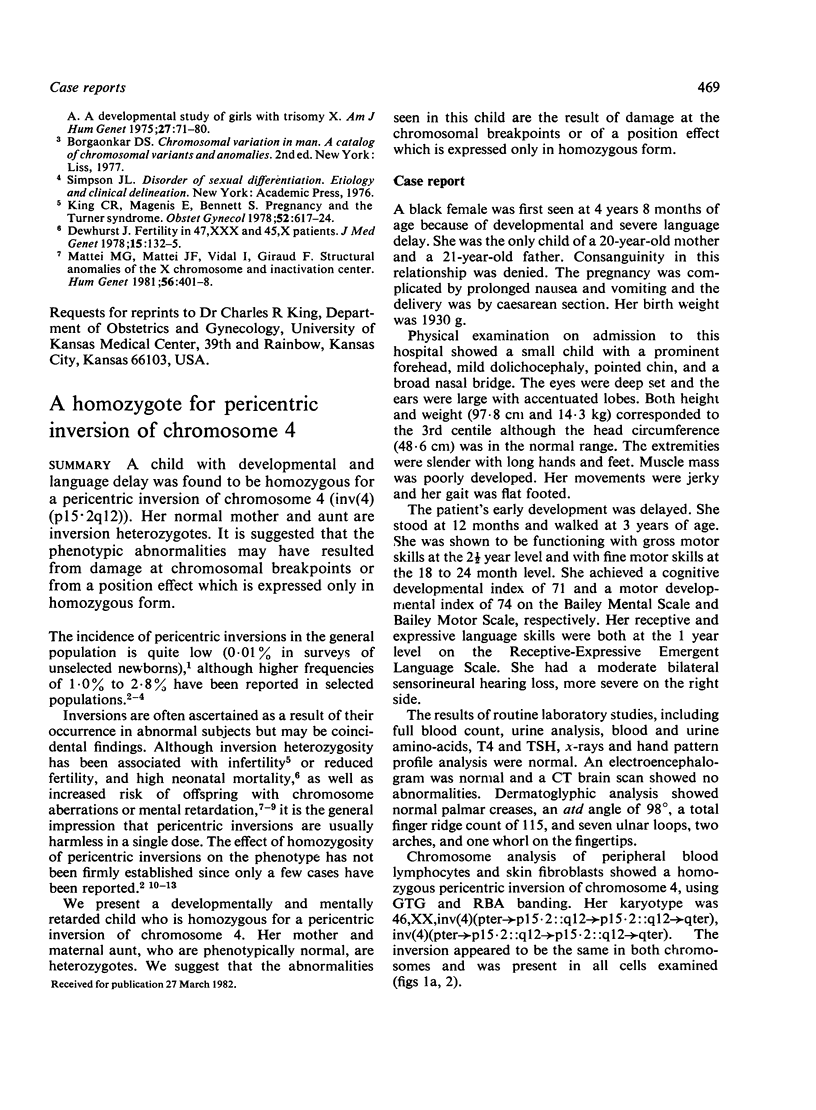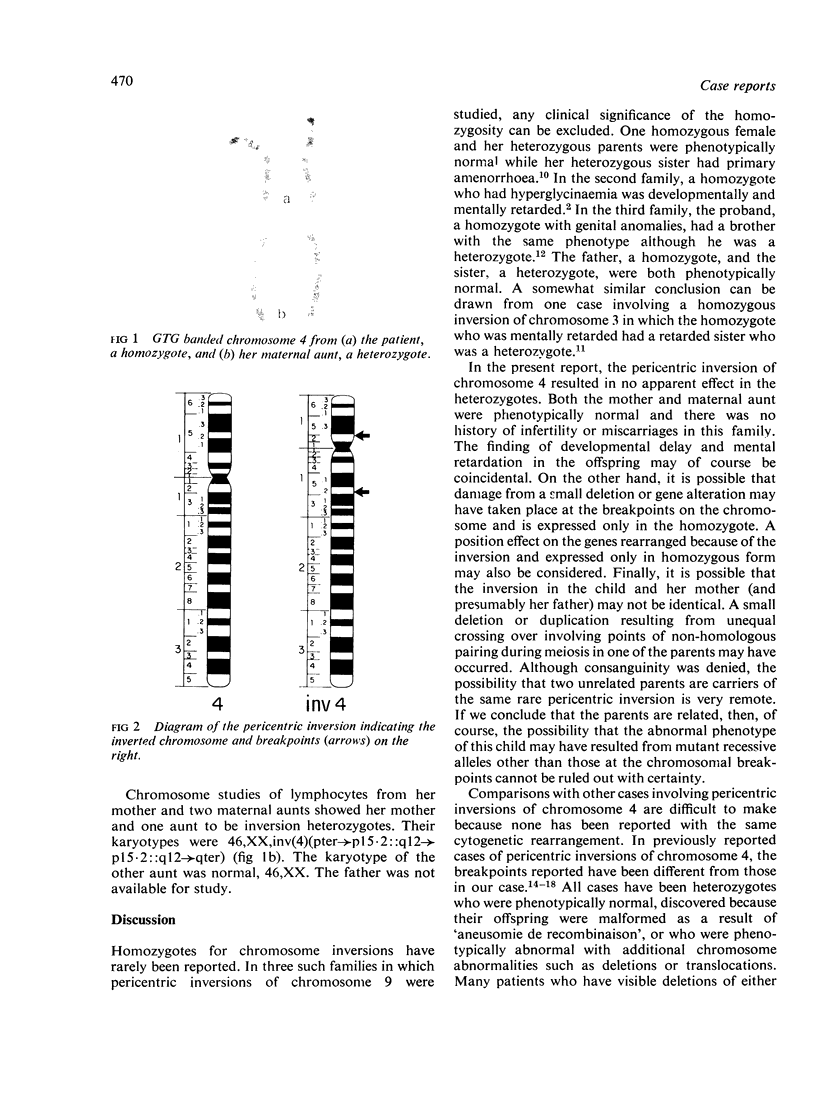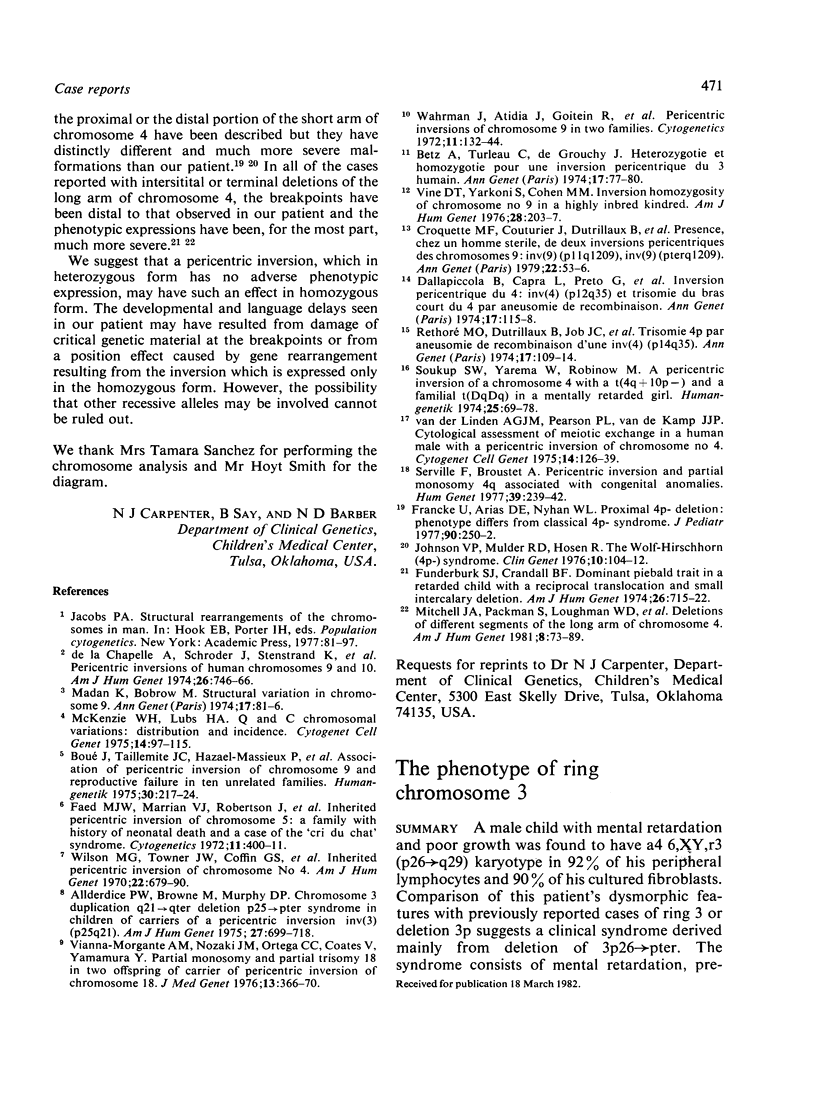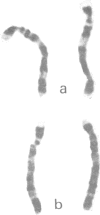Abstract
A child with developmental and language delay was found to be homozygous for a pericentric inversion of chromosome 4 (inv(4) (p15 X 2q12)). Her normal mother and aunt are inversion heterozygotes. It is suggested that the phenotypic abnormalities may have resulted from damage at chromosomal breakpoints or from a position effect which is expressed only in homozygous form.
Full text
PDF


Images in this article
Selected References
These references are in PubMed. This may not be the complete list of references from this article.
- Allderdice P. W., Browne N., Murphy D. P. Chromosome 3 duplication q21 leads to qter deletion p25 leads to pter syndrome in children of carriers of a pericentric inversion inv(3) (p25q21). Am J Hum Genet. 1975 Nov;27(6):699–718. [PMC free article] [PubMed] [Google Scholar]
- Betz A., Turleau C., de Grouchy J. Hétérozygotie et homozygotie pour une inversion péricentrique du 3 humain. Ann Genet. 1974 Jun;17(2):79–80. [PubMed] [Google Scholar]
- Boué J., Taillemite J. L., Hazael-Massieux P., Léonard C., Boué A. Association of pericentric inversion of chromosome 9 and reproductive failure in ten unrelated families. Humangenetik. 1975 Sep 20;30(3):217–224. doi: 10.1007/BF00279187. [DOI] [PubMed] [Google Scholar]
- Dallapiccola B., Capra L., Preto G., Covic M., Dutrillaux B. Inversion péricentrique du 4 : inv(4)(p13q35) et trisomie du bras court du 4 par aneusomie de recombinaison. Ann Genet. 1974 Jun;17(2):115–118. [PubMed] [Google Scholar]
- Faed M. J., Marrian V. J., Robertson J., Robson E. B., Cook P. J. Inherited pericentric inversion of chromosome 5: a family with history of neonatal death and a case of the "cri du chat" syndrome. Cytogenetics. 1972;11(5):400–411. doi: 10.1159/000130206. [DOI] [PubMed] [Google Scholar]
- Francke U., Arias D. E., Nyham W. L. Proximal 4p-deletion: phenotype differs from classical 4p-syndrome. J Pediatr. 1977 Feb;90(2):250–252. doi: 10.1016/s0022-3476(77)80642-2. [DOI] [PubMed] [Google Scholar]
- Funderburk S. J., Crandall B. F. Dominant piebald trait in a retarded child with a reciprocal translocation and small intercalary deletion. Am J Hum Genet. 1974 Nov;26(6):715–722. [PMC free article] [PubMed] [Google Scholar]
- Johnson V. P., Mulder R. D., Hosen R. The Wolf-Hirschhorn (4p-) syndrome. Clin Genet. 1976 Aug;10(2NA-NA-760903-760909):104–112. doi: 10.1111/j.1399-0004.1976.tb00021.x. [DOI] [PubMed] [Google Scholar]
- Madan K., Bobrow M. Structural variation in chromosome No 9. Ann Genet. 1974 Jun;17(2):81–86. [PubMed] [Google Scholar]
- McKenzie W. H., Lubs H. A. Human Q and C chromosomal variations: distribution and incidence. Cytogenet Cell Genet. 1975;14(2):97–115. doi: 10.1159/000130330. [DOI] [PubMed] [Google Scholar]
- Mitchell J. A., Packman S., Loughman W. D., Fineman R. M., Zackai E., Patil S. R., Emanual B., Bartley J. A., Hanson J. W. Deletions of different segments of the long arm of chromosome 4. Am J Med Genet. 1981;8(1):73–89. doi: 10.1002/ajmg.1320080110. [DOI] [PubMed] [Google Scholar]
- Rethoré M. O., Dutrillaux B., Job J. C., Lejeune J. Trisomie 4p par aneusomie de recombinaison d'une inv(4)(p14q35) Ann Genet. 1974 Jun;17(2):109–114. [PubMed] [Google Scholar]
- Serville F., Broustet A. Pericentric inversion and partial monosomy 4q associated with congenital anomalies. Hum Genet. 1977 Nov 10;39(2):239–242. doi: 10.1007/BF00287019. [DOI] [PubMed] [Google Scholar]
- Soukup S. W., Yarema W., Robinow M. A pericentric inversion of a chromosome 4 with a t(4q+10p-) and a familial t(DqDq) in a mentally retarded girl. Humangenetik. 1974;25(1):69–78. doi: 10.1007/BF00281009. [DOI] [PubMed] [Google Scholar]
- Van der Linden A. G., Pearson P. L., Van de Kamp J. J. Cytological assessment of meiotic exchange in a human male with a pericentric inversion of chromosome No. 4. Cytogenet Cell Genet. 1975;14(2):126–139. doi: 10.1159/000130332. [DOI] [PubMed] [Google Scholar]
- Vianna-Morgante A. M., Nozaki M. J., Ortega C. C., Coates V., Yamamura Y. Partial monosomy and partial trisomy 18 in two offspring of carrier of pericentric inversion of chromosome 18. J Med Genet. 1976 Oct;13(5):366–370. doi: 10.1136/jmg.13.5.366. [DOI] [PMC free article] [PubMed] [Google Scholar]
- Vine D. T., Yarkoni S., Cohen M. M. Inversion homozygosity of chromosome no. 9 in a higly inbred kindred. Am J Hum Genet. 1976 May;28(3):203–207. [PMC free article] [PubMed] [Google Scholar]
- Wahrman J., Atidia J., Goitein R., Cohen T. Pericentric inversions of chromosome 9 in two families. Cytogenetics. 1972;11(2):132–144. doi: 10.1159/000130182. [DOI] [PubMed] [Google Scholar]
- Wilson M. G., Towner J. W., Coffin G. S., Forsman I. Inherited pericentric inversion of chromosome no. 4. Am J Hum Genet. 1970 Nov;22(6):679–690. [PMC free article] [PubMed] [Google Scholar]
- de la Chapelle A., Schröder J., Stenstrand K., Fellman J., Herva R., Saarni M., Anttolainen I., Tallila I., Tervilä L., Husa L. Pericentric inversions of human chromosomes 9 and 10. Am J Hum Genet. 1974 Nov;26(6):746–766. [PMC free article] [PubMed] [Google Scholar]



